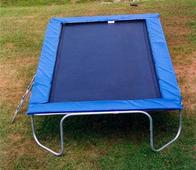Fine tuning the right tension should be the goal when picking out the spring length, tensile strength, and coil count. This will help determine what yield strength of the spring to get (gauge and sizing)
The problem is that almost all newly bought trampolines can give a deep bounce but accelerations levels can vary giving different lift speeds and heights. The thing that makes most people prefer one or the other is the number of free bounces which is the effort it takes after that first bounce and the highest amplitude. The more free bounces it gives you the less effort you have to do to work out. Some people want to stay closer to the mat and some people want to get more air time. Some kids get too crazy and get too much amplitude than the handle and parent often want to get a little less bounce so they don't have to always monitor them in the back yard.
Some people want the deepest bounce and the highest height they can get, so music wire springs would be what they would need to look for as they have the right tensile and yield strength. Some springs are designed to give the fewest free bounces and can cost even more than springs that give the most spring bounces. The other type is wire hard drawn. It is not as thick as piano wire but has a strong yield and tensile strength. This is very expensive and is usually for heavy weight users but still not as good for bouncing as piano wire. Most gymnasts prefer piano wire springs. Figuring out the right tensile straight to the length and coil count can be hard. If the spring is too long, then it will take more bounces to get to the height the bouncer is trying to reach but will give more free bounces in the end. You have to factor in responsiveness to the yield of the spring. This is why someone experienced can tell if a 7,8, 9, or 10+ spring would be a better fit. Also know if the spring is made from music wire or if it is from hard drawn wire.
Music wire is higher quality. Consider it in its natural application. Piano strings, guitar strings. They're tightened & loosened constantly when tuning, they're struck or strummed on, they're exposed to humidity changes etc & their expected to last years.
Music wire is the highest quality wire you can use for a spring given the application on a trampoline. It has the best memory as it retains its tension longer, & can be overstretched much farther and not being deformed or damaged. The professional trampolines that people see in high end gymnasiums/competitions almost always use strings made of music wire. Theirs way more height bouncing on them.
An experienced trampoline dealer should know the right length to diameter to tensile strength for the springs they choose for your trampoline, that is, unless you already know what you want. Different tensile strengths are from springs made with different alloys of medals. Two similar looking and weight springs can have totally different tensile strengths and give a harder or softer bounce, deeper or more shallow, and give more or less free bounces. It is also important to know the number of springs. Cheaper models have more springs but with less quality springs. More is usually a substitute for cheaper alloy springs.
Too many for the weight of the person will be too soft. Too many, too stiff. This is the reason why the weight question on my quiz makes a huge difference in determining spring count and tensile strength of those springs.
Length is just as imporant as the spring count as having a lot of short springs can stretch out too much and cause bounce failure over time when they finally over stretch. Knowing the spring replacement history is also important. There are reviews on springs if you google them. Although it is better to get a sample of a spring before you buy the trampoline to weight it, find out how many grams it weighs. Better yet, get a dozen of them, see if each springs weighs different than the others. I have seen a whole set of springs where some springs are much heavier and others are lighter. I personally return springs that are too light and demand them replacing them with the heavier ones. If one spring goes bunk, then they all usually start to go bunk around the bunk one. So, reading reviews are not the only way to see if the springs will last and have high tensile strength. Any company that has a high quality spring should be happy to send me a spring that I can return. I don't expect them to send me a whole set but one spring from each size they carry is not too much to ask for, as long as I agree to return it.
I had a list of questions to ask your dealer about trampoline springs but I had to take it down. It caused so much confusion. This was before I isolated each quiz instead of one general trampoline quiz.
Note: many people want longer springs with higher coil counts. Just know that they can give a deeper bounce but the bounce can need to work up to momentum. You have to work your way up since it can take more energy to build up inertia. The stiffer models that don't decelerate as much into the mat takes fewer bounces to reach the maximum height. Many people don't care about getting those few extra free bounces and others demand them.
Take the Trampoline Quiz based on your needs
...because they all said they have the best quality and bounce
1-877-336-7890
Open from
8am till 10pm
Rectangle-Trampolines-Reviewed.com
1-877-336-7890
Open from
8am till 10pm




